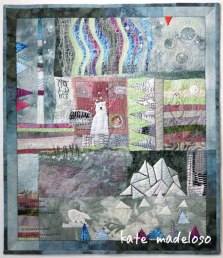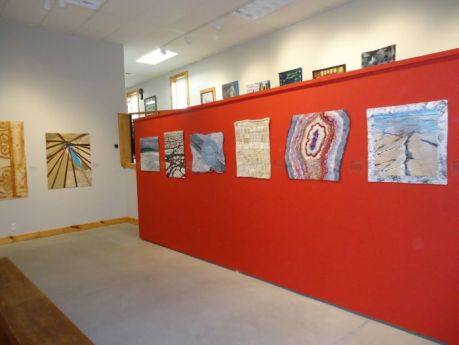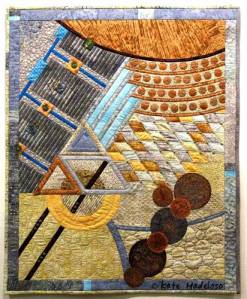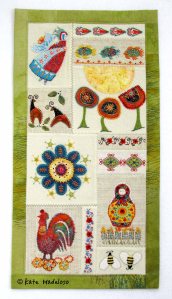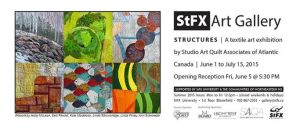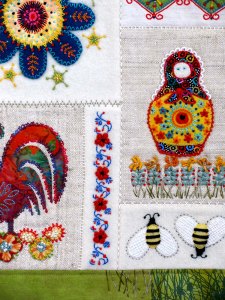My entry “Home is on the Sea Ice” was accepted into the Grand National Oh! Canada 2017 last April. The show opened at the Joseph Schneider Haus National Historic House in Kitchener ON and runs from May 7 to Sep 3, 2017.
The Slow Movement
Simplicity, minimalism, being present in the moment, breathing, hand quilting, hand stitching, hand embroidery. Doing things slowly, by hand – my brain slows down in the process. My head gets clearer and little things I used to fuss about no longer take up space in my thoughts. Less clutter means less clutter.
I’ve had some major health interruptions the past year which has forced me to slow down. Therein lies the message. I am ‘slowly’ regaining focus on all things in my life. I’m not out of the fog yet but I can feel it happening… slowly.
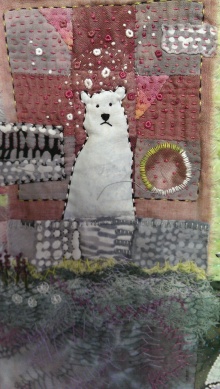
My grandmother, Dora
Thank you to Koozma Tarasoff for his article 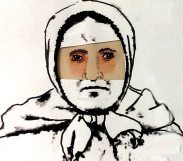 about my art quilt “A Vanishing Culture”.
about my art quilt “A Vanishing Culture”.
Opening of My Corner of the World
My Corner of the World, International, SAQA
Here is a slide show of the 40 pieces that will be in this exhibition, to open May 21 at the Perth Museum in Stratford, ON. I will post the slide show of the national exhibition as soon as it is available.
http://www.saqa.com/memberArt.php?ID=3492
Interesting in that I wanted my piece “A Vanishing Culture” to look as if it is almost vanishing and indeed it does!
A Vanishing Culture
Two of my art quilts, A Vanishing Culture and Fundy Flame Agate have been accepted into SAQA exhibitions – My Corner of the Word, International and National.
The My Corner of the World exhibitions will debut at the Stratford Perth Museum in Stratford, ON, May 21 to August 14, 2016 and will be on tour for two years. There is info on the exhibition’s here.
A Vanishing Culture, was one of the 41 entries juried in to the show out of 189 pieces from 115 artists, SAQA members, from around the world. It is a piece I created specifically for the Call For Entry and was inspired by my Russian grandmother, Dora. I wanted this piece to look like it had travelled through time and like the title it might vanish if not acknowledged.
I was in my late 30’s when my mother, who I knew had Russian heritage, revealed a secret she had kept from me and my siblings until that time.
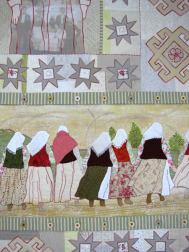
closeup of A Vanishing Culture
Her mother, Evdoitia Oosichoff, who I knew as Dora Streliaf, had come to Canada by ship with 7500 other Russian peasants in 1897 from the Georgia area of southern Russian. They called themselves ‘Doukhobors’ which translates to ‘Spirit Wrestlers’ in English and were one of the largest group of immigrants to land in Canada.
All I had known about the Doukhobors was that they used to protest nude down the streets of Nelson, BC back in the 1950’s and that they burnt their own homes and schools. They wanted to demonstrate that material wealth was against their religion. They defied anything to do with government regulations involving the keeping of statistics and mandatory placement of their children in public schools. This small group of less than 200 protesters were called ‘The Sons of Freedom’ and were a renegade group of the larger community of 7500 Doukhobors in southern British Columbia. It is a shame that all Doukhobors were then labelled and blamed for the actions of the Sons of Freedom.
My uncle has told me several stories about his living near Castlegar BC, as a young child of his mother moving all the household belongings out into an apple orchard, including his bed which was put under an apple tree. She lived in fear of having their house burnt to the ground. He recently gave me a wool yarn rug handmade by my grandmother and her mother. And a hand woven linen shirt which he called Dora’s ‘birthing’ shirt, a shirt she wore during the delivery of her six children. And there began my journey into my heritage and this rich and often over looked culture.

24″ x 70″ A Vanishing Culture
In Russia the Doukhobors had been persecuted by the Czar as they believed it was wrong to kill and they refused to fight for the Czar. With the help of Leo Tolstoy and British Quakers they negotiated with the Canadian government to bring three shiploads of people to settle the farmlands of the Canadian prairies, and to help to build the railroads and integrate into Canadian society. The government acknowledged them as pacifists so they would not be called upon to bear arms to fight in any wars.
The majority of the immigrants were women and children as their men had been imprisoned, tortured and killed in Russian camps. In 1895 in three areas of southern Russian, they publicly burned their weapons in what is now known and still celebrated annually as ‘The Burning of Arms’. This may have been the first pacifist protest in modern times.
The info below is from http://www.thecanadianencyclopedia.ca/en/article/doukhobors/
The Doukhobors rejected church liturgy, believing that god dwells in each human being and not in a church; they rejected secular governments; and practiced pacifism. They replaced the Bible with orally transmitted psalms and hymns, which they called the Living Book. These are sung to this day at the Molenie (religious gatherings). Group decisions are made collectively at Sobranie (community meetings). Doukhobors do not use any religious symbols at these meetings except for the display of bread, salt and water, which represent the elements that sustain life. Some Doukhobors revere their chosen leaders, whom they regard as especially inspired by god, but Doukhobors generally believe that all people are equal because all have god within them. Many of them still live by the slogan coined by one of their leaders, “toil and peaceful life.” Most Doukhobors no longer live communally, but many are still vegetarians and all practice pacifism.
In Canada in 1941 the self-identified Doukhobor population reached 16,898 and by 2011 the census number was down to 2,290 still active in their culture.
Structures Entry wins an Honorable Mention
The SAQA Atlantic travelling exhibition ‘Structures’ has now moved on to the Gallery at the Guild, Charlottetown, PEI until August 30th. Then on to Cape Breton at the Inverness County Centre for the Arts Gallery, September 27 to October 18, 2015. I was so pleased my ‘Taliesin Mosaic’ was awarded by the juror, Alan Syliboy, an Honorable Mention along with Deb Plestid. Linda Finley was awarded the Best of Show.
My inspiration for Taliesin Mosaic comes from the work of the architect Frank Lloyd Wright best known for his geometric elements.
In the 1950’s Wright designed a color palette called Taliesin which he used in his textile lines. This muted palette inspired me to go through my fabric stash and pull similarly colored materials which became the framework for this structure and its embellishment.
Wright’s mosaic designs consist of small parts connected by geometric elements – circles, squares, and triangles. It was my intent to create a balance between these elements and hand embroidery as one component led to another.
Award of Merit for Traditional Handwork
This is late in announcing but finally found some time to post. “By Hand With Love” was among the award winners for the Grand National Quilt Show in Kitchener, ON. Thank you very much to Creative Sisters Quilt Studio for their gift box full of books and thread and wonderfulness. And thank you to the organizers of the Grand National. We in Canada do not have many large shows we can participate in. I know the amount of work that goes into putting on a show so kudos to the organizing committee and all the volunteers!!
‘Structures’ Show opens June 5th in Antigonish NS
Award of Merit Grand National Quilt Show
On Mother’s Day I received a phone call from Kathleen Bissett happily announcing that I had won an Award of Merit for my entry “By Hand, With Love”. Lovely way to start the day! Here is a link to the website to view my entry and artist statement. http://www.grandnationalquiltshow.ca/CONNECTIONS%20WINNERS.html?id=337&type=0&calendar=3 Unfortunately the photo I sent in was not very good. My old camera was not cooperating. My friend Karen Henry http://www.karenhenry.ca/ visited the show while on a teaching tour and took a way better photo. Will post in a bit – there is a raging rain storm outside and internet connection has gone all wonky.
Here is a closeup:


